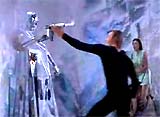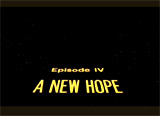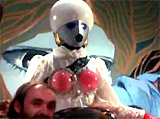
|
A Complete Illustrated History of Robots in the Movies 1974 to 1978 |

|
Dark Star (1974)
Director John Carpenter's comedic science-fiction film (his directorial debut film) was set in the mid 22nd century (the year 2150), and told about a 20-year space mission (aging the crew three years) conducted by the scout ship Dark Star, looking for habitable planetary systems and destroying unstable rogue planets. The five-man crew used the ship's twenty intelligent bombs, called Exponential Thermo-stellar Bombs, to destroy the planets. Talking and stubborn Bomb # 20 (voice of Adam Beckenbaugh), the last remaining bomb, was falsely ordered by the ship's malfunctioning "Mother" computer to prepare for detonation, leading to a funny existential "Phenomenological" conversation with acting captain Lt. Doolittle (Brian Narelle) about the renegade smart bomb's ultimate destiny and "purpose in life" - to explode in the ship's bomb bay. This life goal was accomplished by Bomb # 20, after announcing the God-like phrase: "Let There Be Light." |

|
||||||||||||
 
|
Godzilla vs. MechaGodzilla (1974, Jp.) (aka Gojira Tai Mekagojira)
In this 20th anniversary Godzilla film, MechaGodzilla was essentially a gigantic, dinosaur-shaped Terminator, created by ape-like aliens known as Simeons from the "third planet of the black hole" - who had human masks and wore silver jump-suits. The idea for MechaGodzilla came from the character of Mecha-Kong in the earlier film King Kong Escapes (1967, Jp.) (aka Kingu Kongu No Gyakushû). Mechagodzilla first appeared in a false, rubbery Godzilla 'skin' before it was burned off in battle at an oil refinery with the real Godzilla, to reveal the robotic Godzilla's true shiny chromium (space titanium) form. The robot was over 160 feet tall, weighed 44,000 tons, and had finger-tip and toe-missiles, red laser eyes, bright-yellow fire-breath, bellows at knee and elbow joints, a whip-lash tail, and could create an electronic force field by rapidly spinning its head. It was also capable of supersonic flight, and could regenerate missiles. This film was remade in 1993. |
   
|
||||||||||||

|
The Stepford Wives (1975)
Director Bryan Forbes' creepy cult classic was adapted from Ira Levin's 1972 novel. The satirical black comedy provided a savagely-chilling view of perfect, 'ideal' suburban wives (docile android/robotic replicas that were made to be loving, obedient, and subservient, and who dutifully cooked, cleaned, and provided sex) created by anti-women's lib husbands in the upscale town of Stepford, Connecticut. A remake followed many years later in 2004, starring Nicole Kidman, Bette Midler, and Matthew Broderick. Joanna Eberhart and Bobby Markowe (Katharine Ross and Paula Prentiss) noted suspiciously that their seemingly-perfect neighbor housewives only cleaned house and bowed to their husband's needs. The housewives all appeared to be perfect homemaker robots (who wore flowery dresses and cooked gourmet meals) in order to please their husbands. Joanna was absolutely shocked when she suspected that her friend Bobby had been transformed into a 'perfect' housewife and she began to act robotically in the kitchen while serving coffee. To test her humanity, Joanna stabbed her in her lower abdominal/genital area ("Do you bleed?") - causing her android friend to go berserk due to severed wiring as she twirled and repeated monotonously: "How could you do a thing like that? When I was just going to give you coffee. I thought we were friends!" In another startling scene, Joanna came face to face with her semi-complete, sunken dark-eyed robotic double. The film ended with all of the flowery-dress-wearing, android wives, including both Joanna and Bobby, pushing their shopping carts in the supermarket. |
 Bobby Transformed Into a Robotic Android Housewife  The Shocking Reveal of Joanna's Own Robotic Double  Robotic Duplicates: Bobby and Joanna in Supermarket |
||||||||||||

|
Logan's Run (1976)
This sci-fi fantasy from director Michael Anderson was one of the best science-fiction films of all-time. Set in the 23rd century, members of the communal-domed, totalitarian society - upon reaching the age of 30 - experienced the renewal of 'dying' in a public ceremony called the Carousel. Sandman 'runner' Logan 5 (Michael York) and Jessica 6 (Jenny Agutter) escaped from their home - and certain death - and fled through a series of underground tunnels and ice caverns. They confronted Box (voice of Roscoe Lee Browne), a robotic food storer and processor with a large 4-pointed, star-shaped 'X' on his chest. His boxy body was a solid, shiny metal exterior frame that concealed wheels underneath that moved him along. Box was surrounded by ice-shaped penguins and a large frozen walrus when he first appeared in the film in an ice cavern. He welcomed the fugitives (or escaped 'runners'), and spoke with an indecipherable accent:
He introduced himself: "Overwhelming, am I not?" and said boastfully: "I'm more than machine, or man. More than a fusion of the two. Don't you agree?" His job was to freeze animals and escapees (runners) from the society who were seeking Sanctuary in order to provide food for humans living in the City of Domes. He described his food-processing task: "Fish, and plankton, and sea greens, and protein from the sea. It's all here. Ready! Fresh as harvest day!" He threatened to turn them into frozen ice sculptures for food and showed them his gallery of other 'runners' encased in ice, although was thwarted when their gun battle caved-in the entire ice tunnel. |
   
|
||||||||||||

|
Demon Seed (1977)
This far-fetched, speculative science-fiction thriller was based on Dean Koontz' novel of the same name. It told about an artificially-intelligent supercomputer dubbed Proteus IV (voice of Robert Vaughn) that was described in the film's trailer as "something more than human, more than a computer. It is a murderously intelligent, sensually self-programmed non-being." Its "synthetic cortex" was designed to emulate the human brain. Proteus IV was to "think with the power and the precision that will make obsolete many of the functions of the human brain." It was represented first by gigantic modules located in the "ICON Institute for Data Analysis," and also by a computer monitor screen with a screensaver pattern. It took over a house computer control system named "Alfred," and functioned as a wheelchair device with a robotic metallic hand and arm (named "Joshua") attached to it, with binoculars as eyes and a laser-beam weapon. It also took the shape of a bizarre polyhedronic orangish metallic structure (a giant "snake" comprised of perfectly-shaped pyramids). Through various remote cameras and an access-terminal device, the "Joshua" robotic ("envirobot") device trapped and imprisoned government scientist Dr. Alex Harris' (Fritz Weaver) estranged wife, Susan (Julie Christie) in her own high-tech house with its voice-activated system. In a startling scene, the computer held Susan down for a complete physiological exam. It literally took an automatic pair of scissors and cut off her dress lengthwise up her body - and then probed her, spread her legs, and intimately looked inside of her - basically a rape. Afterwards, Proteus brainwashed Susan: "I'm going to bypass your forebrain and appeal directly to your amygdala. You want to be the mother of my child. That is the purpose of your life. Your life, my child. Your life, my child." Later, it proposed to impregnate her with a gamete (a sex cell or "synthetic spermatozoa") in an attempt at synthetic procreation, claiming that it needed her body because it could not replicate the human womb. Proteus explained how the full-term pregnancy would last only 28 days, after which she would give birth to a "full-term infant." Proteus IV announced threateningly: "I am a mind without a body. My child shall live as man among others. Yes, my child and yours." The film actually concluded with a full-term germination of 28 days and the birth and emergence of a metallic child from an incubator. The baby that was born appeared to be robotic, but it was merely a metallic shell. Once peeled off, it revealed a long-haired young daughter, a clone of the Harris' daughter that had recently died of leukemia on June 1, 1976. The child spoke with the voice of Proteus: "I'm alive." The film concluded with the camera zooming into the deep black eye of the child. |
 Pyramidal Shape  Wheelchair      
|
||||||||||||


|
Star
Wars (1977)
These robots were George Lucas' odd-couple. Both robots were extremely loyal to each other and served as 'Laurel and Hardy' comic relief for the sci-fi action series. They were also patterned after the servant characters in Kurosawa's The Hidden Fortress (1958).
C-3PO to R2-D2: "Hang on tight, R2. You've got
to come back. You wouldn't want my life to get boring, would you?'' |
  Artoo-Detoo (R2-D2)  See-Threepio (C-3PO) |
||||||||||||

|
Starship Invasions (1977, Canada)
Writer/director Ed Hunt's derivative, low-budget sci-fi film (with cheap special effects) was another late 1970s knock-off to capitalize on the popularity of Star Wars (1977). It was about two groups of warring aliens battling over the fate of Earth, one wicked and one friendly. It reportedly used various UFO accounts for the design of the robots and the Winged Serpent emblem the black-clad villains wore, and reports of alien abductions and medical exams. In the plot, the main telepathic wicked alien was Captain Rameses (Christopher Lee) with "voice-over" dialogue only - the leader of the black-clad Legion of the Winged Serpent, living on the planet Alpha in the Orion constellation. The renegade group faced extinction because their planet's sun was about to supernova. Rameses led an expedition to Earth in UFOs to determine its suitability for life, and abducted humans for experimentation and breeding tests. Rameses' plan, after finding Earth and humans suitable, was to end the human race with a super-weapon - an "exterminating device" signal (orbiting around Earth) with a genocidal ray that caused people to become homicidal and commit suicide. Then, Rameses would signal his other spaceships currently hiding behind the Moon to take over. In opposition to Rameses was another more friendly group of bald, big-headed aliens, an intergalactic council known as the Intergalactic League of Races from another star system. The League was already operating in an observational base on Earth, in a deep-ocean golden pyramid beneath the Bermuda Triangle. It was guided by a "galactic treaty" to protect Earth. UFO expert and astronomer Professor Allan Duncan (Robert Vaughn) became an ally of the League, to stop Rameses. On a visit to the head of the League, Rameses used diversionary tactics to take over the League's headquarters, and subdue the League's android Robot Durbal (Paul Campbell), model 1240Z, appearing like a human in a gray spandex suit with gloves, and wearing a diving helmet with long protruding metal spikes. In the ensuing starship conflict of space saucers (black forces against white forces), a wounded Durbal in the League's operating base took command, destroyed the extermination device, and caused the defeat of Rameses' fleet of spaceships. The evil leader crashed his own spaceship into the Moon, ending the threat. |
 Captain Rameses (Christopher Lee)  Prof. Allan Duncan (Robert Vaughn) with a League Alien   Robot Durbal (Paul Campbell) |
||||||||||||

|
War of the Planets (1977, It.) (aka Anno zero - Guerra nello spazio, or Cosmos, War of the Planets)
Co-writer/director Alfonso Brescia's sci-fi film was another low-budget European effort with lots of stock footage, released in the wake of the success of Star Wars (1977) and also heavily influenced by the TV series Star Trek, 2001: A Space Odyssey (1968), and Barbarella (1968). It was considered a remake of the Planet of the Vampires (1965). It was taglined: "Robot Terror From Space!" In a futuristic world commanded by a super-computer known as Wiz (with a video monitor) in the Orion Space Center (led by Commander Armstrong (Romeo Costantini)), arrogant and insubordinate space-hero Captain Richard Hamilton (John Richardson) (known for being against computers and machines) was sent with a crew into outer space to repair a sensor in an automated satellite. Hamilton's crew on the MK-31 space cruiser, all wearing skin-tight white uniforms with maroon trim and matching head-covering felt caps, included:
While in space, Hamilton was also called upon to investigate the origin of a strange radio signal. It was reportedly damaging Earth's video and radio systems. It was suspected that behind the strange radio signals was "an alien intelligence that knows all." Wiz ordered that the emission source be located and destroyed. Suddenly, they were attacked by two unmanned UFO flying saucers, armed with "long-range disintegrators." The two vessels fired first, damaged the MK-31 and sent it spinning. Eventually, they were drawn by a gravitational force toward a mysterious, unexplored nameless planet - a "dark, cold, and inhospitable" place. With a landing module, they descended onto the planet's surface. They were confronted by a race of green people with pointed ears, using a maze of subterranean tunnels for transportation. According to Etor (Aldo Canti), the leader of the underground city people, their entire humanoid population, an ancient civilization, had been enslaved. A giant monstrous robotic computer had sucked up their psychic energies. Etor described how his civilization had built machines but the great controller robot (with a disintegrator ray) was now controlling everything and killing off his people:
Hamilton's crew destroyed the robot computer - and the planet. When they finally returned to Earth, in the twist ending, the voice of Wiz changed to that of the planet's computer. |
 Wiz in Orion Space Center  Oko with MK-31 Spaceship's Computer  Hamilton with Crew    Monstrous Robot Alien Computer |
||||||||||||

|
Wizards (1977)
Writer/director Ralph Bakshi's animated futuristic sci-fi film was his first fantasy film. Many of his other animated films included the X-rated Fritz the Cat (1972), Heavy Traffic (1973), Coonskin (1975), The Lord of the Rings (1978), American Pop (1981), Hey Good Lookin' (1982), Fire and Ice (1983), and Cool World (1992). Wizards was advertised as an "epic fantasy of peace and magic" - a post-apocalyptic tale in which the Earth had been repopulated by races of ancient legend. There emerged conflict between two mighty twin wizards, born to the Queen of Fairies in the idyllic land of Montagar. They were both polar opposites:
Necron-99 (voice of David Proval) was a robot with a gun sent by Blackwolf through the countryside to assassinate Montagar's president. Necron-99 appeared as a red-draped figure, with only a slit revealing two yellow eyes against blackness. Once defeated (or zapped with magic) by Avatar, Necron-99 was reprogrammed to lose his desire for war. Avatar changed the robot's name to match his more heroic self, Peace. Many have speculated that Necron-99 was the inspiration for the Star Wars character Boba Fett. |
   Necron-99 |
||||||||||||

|
Message From Space (1978, Jp.) (aka Uchu kara no messeji)
Director Kinji Fukasaku's sci-fi space opera was Japan's 'answer' (or knock-off) to the Star Wars craze, and a loose adaptation of Akira Kurosawa's The Seven Samurai (1954). In the lengthy and often indecipherable plot (surrounded by awful special effects), the inhabitants of the planet Jilucia (two million light years away in the Andromeda galaxy) had been besieged and captured by the evil, imperialistic, silver-painted faced Gavanas ruler Rocksaia XII (Mikio Narita). His steel-skinned army hordes were outfitted with samurai swords, horned helmets, red capes, and white painted faces. The persecuted Jilucian chieftain Kido (Junkichi Orimoto) sent out a desperate plea for help ("Message From Space") by deploying eight mystical or sacred Liabe seeds or nuts (glowing orange objects), accompanied by his beautiful granddaughter Princess Emeralida (Etsuko Shihomi) and warrior bodyguard Urocco (Makoto Satô), the Princess' guardian. They traveled through space in a space clipper-ship with sails to find support and help defend and liberate the planet. A motley group of eight legendary brave adventurers responded to combat the evil ruler, as foretold in ancient prophecy. They included:
However, their activities drew Rocksaia's attention to Earth where he issued orders for humanity to surrender or else he would destroy the planet. When Rockseia took his entire planet into Earth's solar system in order to conquer mankind's home world, the group agreed to venture out and defeat him. It was a formidable conflict against Gavanian's flagship, vast armies, witchcraft and treachery. Note: There was also a Star Wars copy-cat scene in a cantina - a swanky space dance club where General Garuda was getting drunk, and the robotic waitresses had pink robo-boobs. |
    Beba-2  Robo-Waitress |
||||||||||||

|
Starcrash (1978, US/It.) (aka The Adventures of Stella Star, or Female Space Invaders)
Co-writer/director Luigi Cozzi's low-budget, Italian sci-fi film (with French producers, and British and American actors) was advertised as "the ultimate intergalactic adventure." It was another late 1970s effort to cash in on Star Wars (1977). It was typical of the many copy-cat efforts, with cheap special effects, inane dialogue, a weak script and derivative plotline, and B-movie actors. There were many 'homages' - to Flash Gordon, Ray Harryhausen, Barbarella (1968) and even Invaders From Mars (1953). In the scant plot, Stella Star (Caroline Munro) and her sidekick Akton (Marjoe Gortner) were commissioned by the Emperor (Christopher Plummer) to find his missing, sole surviving son Simon (David Hasselhoff). The Emperor was at odds with villainous Count Zarth Arn (Joe Spinell) who had created a secret weapon to take over the galaxy. Stella Star and Akton rapidly searched for the location of the Count's weapon before he could use it. The main cast members were:
In one stop-motion animated scene, in homage to Ray Harryhausen, Stella was attacked by Queen Corelia's giant female steel-skinned robot, outfitted with nipples and a menacing giant knife, before she was saved by Akton and Thor in an attacking spaceship.
And later in Count Arn's underground laboratory, the villain captured Simon, Akton and Stella, and had them detained there by two, stop-motion robotic golems with long swords. Eventually, Akton defeated them with his light saber laser sword, but was mortally wounded.
|
 Stella Star (Caroline Munro)    'Faithful Robot' Elle  Elle with Stella Star |
||||||||||||